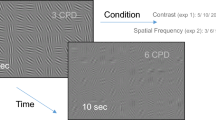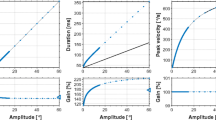Abstract
Two experiments were conducted to examine the influence of the spatial frequency content of natural images on saccadic size and fixation duration. In the first experiment 10 pictures of natural textures were low-pass filtered (0.04–0.76 cycles/deg) and high-pass filtered (1.91–19.56 cycles/deg) and presented with the unfiltered originals in random order, each for 10 s, to 18 participants, with the instruction to inspect them in order to find a suitable name. The participants’ eye movements were recorded. It was found that low-pass filtered images resulted in larger saccadic amplitudes compared with high-pass filtered images. A second experiment was conducted with natural stimuli selected for different power spectra which supported the results outlined above. In general, low-spatial frequencies elicit larger saccades associated with shorter fixation durations whereas high-spatial frequencies elicit smaller saccades with longer fixation durations.






Similar content being viewed by others
References
Andrews, T. J., & Coppola, D. M. (1999). Idiosyncratic characteristics of saccadic eye movements when viewing different visual environments. Vision Research, 39, 2947–2953.
Becker, W. R., & Jürgens, R. (1979). An analysis of the saccadic eye movement system by means of double step stimuli. Vision Research, 19, 967–983.
Breitmeyer, B. G. (1975). Simple reaction time as a measure of the temporal response properties of the transient and sustained channels. Vision Research, 15, 1411–1412.
Buswell, G. (1935). How people look at pictures. A study of the psychology of perception in art. Chicago: University of Chicago Press.
Deubel, H., & Elsner, T. (1986). Threshold perception and saccadic eye movements. Biological Cybernetics, 54, 351–358.
Di Lollo, V., & Woods, E. (1981). Duration of visible persistence in relation to range of spatial frequencies. Journal of Experimental Psychology: Human Perception and Performance, 7, 754–769.
Findlay, J. M. (1982). Global processing for saccadic eye movements. Vision Research, 22, 1033–1045.
Groner, R., & Menz C. (1985) The effects of stimulus characteristics, task requirements and individual differences on scanning patterns. In R. Groner, G. W. McConkie & C. Menz (Eds.), Eye movements and human information processing (pp. 239–250). Amsterdam: North Holland.
Heller, D., & Müller, H. (1983). On the relationship between saccadic size and fixation duration in reading. In R. Groner, C. Menz, D. F. Fisher & R. A. Monty (Eds.), Eye movements and psychological functions: International views (pp. 287–302). Hillsdale: Lawrence Erlbaum.
Henderson, J. M., & Hollingworth, A. (1998). Eye movements during scene viewing: An overview. In G. Underwood (Ed.), Eye guidance in reading and scene perception (pp. 269–293). Amsterdam: Elsevier.
Henderson, J. M., Weeks, P. A., Jr., & Hollingworth, A. (1999). Effects of semantic consistency on eye movements during scene viewing. Journal of Experimental Psychology: Human Perception and Performance, 25, 210–228.
Itti, L., & Koch, C. (2000). A saliency-based search mechanism for overt and covert shifts of visual attention. Vision Research, 40, 1489–1506.
Krieger, G., Rentschler, I., Hauske, G., Schill, K., & Zetzsche, C. (2000). Object and scene analysis by saccadic eye-movements: An investigation with higher-order statistics. Spatial Vision, 13, 201–214.
Land, M. F., & Hayhoe, M. (2001). In what ways do eye movements contribute to everyday activities? Vision Research, 41, 3559–3565.
Lupp, U., Hauske, G., & Wolf, W. (1976). Perceptual latencies to sinusoidal gratings. Vision Research, 16, 969–972.
Mannan, S., Ruddock, K. H., & Wooding, D. S. (1995). Automatic control of saccadic eye-movements made in visual inspection of briefly presented 2-D images. Spatial Vision, 9, 363–385.
Mannan, S. K., Ruddock, K. H., & Wooding, D. S. (1996). The relationship between the locations of spatial features and those of fixations made during visual examination of briefly presented images. Spatial Vision, 10, 165–188.
Mannan, S. K., Ruddock, K. H., & Wooding, D. S. (1997). Fixation patterns made during brief examination of two-dimensional images. Perception, 26, 1059–1072.
Menz, C., & Groner, R. (1986) Saccadic programming with multiple targets under different task conditions. In K. O’Regan & A. Levy-Schoen (Eds.), Eye movements: From physiology to cognition (pp. 95–103). Amsterdam: Elsevier/North-Holland.
Parkhurst, D. J., & Niebur, E. (2003). Scene content selected by active vision. Spatial Vision, 16, 125–154.
Parkhurst, D., Law, K., & Niebur, E. (2002). Modeling the role of salience in the allocation of overt visual attention. Vision Research, 42, 107–123.
Peterzell, D. H., & Teller, D. Y. (1996). Individual differences in contrast sensitivity functions: The lowest spatial frequency channels. Vision Research, 36, 3077–3085.
Salthouse, T. A., & Ellis, C. L. (1980). Determinants of eye-fixation duration. American Journal of Psychology, 93, 207–234.
Tatler, B. W., Baddeley, R. J., & Gilchrist, I. D. (2005). Visual correlates of fixation selection: Effects of scale and time. Vision Research, 45, 643–659.
Turano, K. A., Geruschat, D. R., & Baker, F. H. (2003). Oculomotor strategies for the direction of gaze tested with a real-world activity. Vision Research, 43, 333–346.
Walther-Müller, P. U. (1993). Zur Messung von Augenbewegungen: Beschreibung der Software zur Analyse von Augenbewegungsdaten. Research Report 1993-3, Department of Psychology, University of Bern.
Wilson, H. R., & Bergen, J. R. (1979). A four mechanism model for threshold spatial vision. Vision Research, 19, 19–32.
Yarbus, L. (1967). Eye movements and vision. New York: Plenum Press.
Acknowledgment
We gratefully remember the many discussions with Dieter Heller in which he added his perspective, often resulting in a deeper understanding of the visual and cognitive processes under study. After his untimely death, we miss him strongly as a unique friend and colleague. This article is dedicated to his memory. This research was supported by grants of the Swiss National Science Foundation. Correspondence concerning this article should be addressed to: Marina Groner, Department of Psychology, University of Bern, CH-3000 Bern 9, Switzerland (e-mail: marina.groner@psy.unibe.ch).
Author information
Authors and Affiliations
Corresponding author
Rights and permissions
About this article
Cite this article
Groner, M.T., Groner, R. & von Mühlenen, A. The effect of spatial frequency content on parameters of eye movements. Psychological Research 72, 601–608 (2008). https://doi.org/10.1007/s00426-008-0167-1
Received:
Accepted:
Published:
Issue Date:
DOI: https://doi.org/10.1007/s00426-008-0167-1




